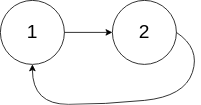Q:
Given a linked list, determine if it has a cycle in it.
To represent a cycle in the given linked list, we use an integer
pos which represents the position (0-indexed) in the linked list where tail connects to. If pos is -1, then there is no cycle in the linked list.
Example 1:
Input: head = [3,2,0,-4], pos = 1 Output: true Explanation: There is a cycle in the linked list, where tail connects to the second node.

Example 2:
Input: head = [1,2], pos = 0 Output: true Explanation: There is a cycle in the linked list, where tail connects to the first node.

Example 3:
Input: head = [1], pos = -1 Output: false Explanation: There is no cycle in the linked list.

A:
First, use Set.
/**
* Definition for singly-linked list.
* struct ListNode {
* int val;
* ListNode *next;
* ListNode(int x) : val(x), next(NULL) {}
* };
*/
class Solution {
public:
bool hasCycle(ListNode *head) {
unordered_set<ListNode*> S;
ListNode* runner = head;
while(runner != nullptr){
if(S.contains(runner)){
return true;
}
S.insert(runner);
runner = runner->next;
}
return false;
}
};
follow up: without extra space/*** Definition for singly-linked list.* struct ListNode {* int val;* ListNode *next;* ListNode(int x) : val(x), next(NULL) {}* };*/class Solution {public:bool hasCycle(ListNode *head) {if(!head)return false;auto slow =head;auto fast = head->next;while(fast){if(slow == fast)return true;slow = slow->next;if(fast->next == nullptr)return false;fast = fast->next->next;}return false;}};
那就用已给的空间了。 例如用head节点(和head.next) 可是,如何防止被我们变换的node不是重复节点呢?
“you could record the ith(i = 1,2,4,8..........) ListNode* and compare it to your iterating ListNode*"
Mistakes:
Learned:
No comments:
Post a Comment